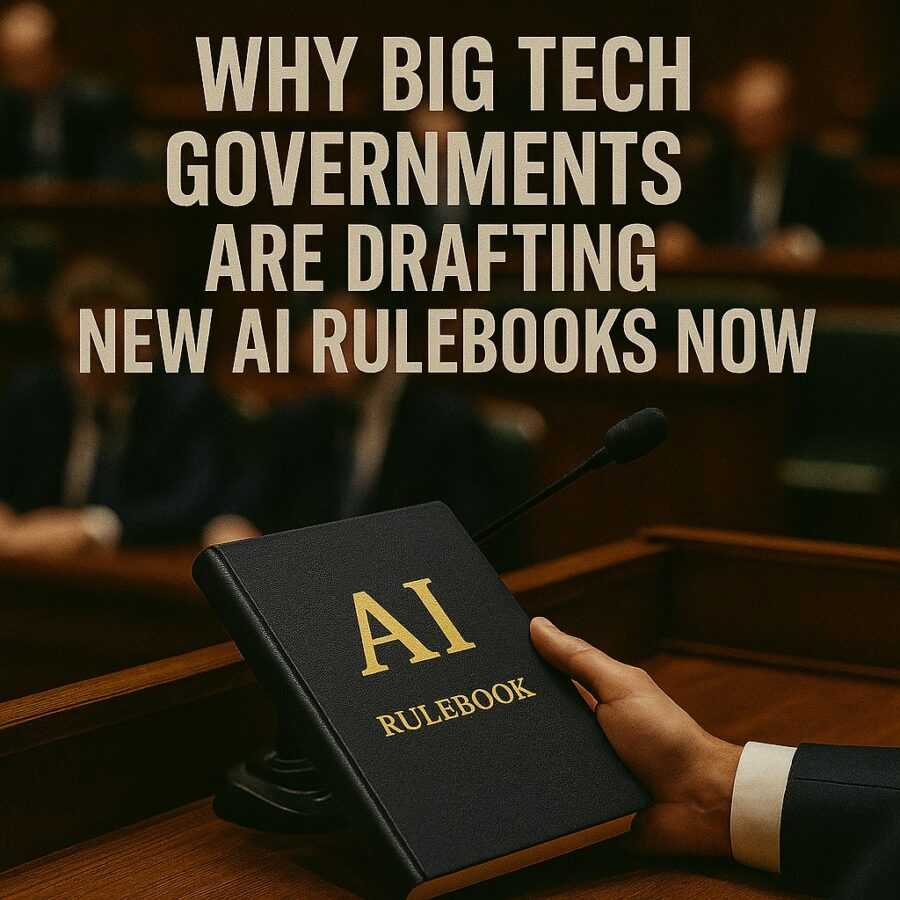Views: 2
Governments and major technology firms are rewriting the rules of the digital age. The headline is blunt and urgent: Big Tech Governments Are Drafting New AI Rulebooks Now. Lawmakers across continents, national research institutes, and leading platforms are moving in parallel. They are responding to a fast shift in capability, a rising set of harms, and public demand for safeguards. This article explains what is happening, why it is happening now, and what it means for companies, researchers, and citizens.
A new moment for policy
Artificial intelligence has reached a new scale of impact. Models now create text, images, and video that are hard to distinguish from human work. Systems that automate hiring, lending, or medical triage touch life changing decisions. National security and misinformation risks are rising. In response, regulators are no longer debating whether to act. They are building frameworks to manage capabilities and governance. The EU has moved first with a comprehensive statute. Other states are now creating institutions and rules that target specific risks and use cases. (Digital Strategy)
The capability shock that forces a response
A single factor drives much of the urgency. Large generative models and multimodal systems now operate at scale in the real world. Their outputs can influence markets, elections, and public health. When tools can generate convincing deepfakes or automate targeted disinformation at low cost, the harms shift from hypothetical to immediate. That capability shock compresses the policy timeline. Leaders who once favored voluntary codes now insist on enforceable obligations. The EU’s law already sets mandatory requirements for high risk systems, and member states are activating implementation steps. (Digital Strategy)
Policy is catching up across multiple fronts
Regulation is not one thing. It is a set of parallel moves: statutes, guidance documents, institutional launches, and transnational agreements. Consider four examples that show the breadth of action.
- The European Union enacted its AI regulation and moved to implement specific obligations for powerful general purpose models and other high risk systems. National agencies and timelines for compliance are now active. (Digital Strategy)
- The United Kingdom created a national AI safety research body and published international safety analysis. The UK is investing in an AI Safety Institute that will provide independent technical advice and governance tools. (AI Security Institute)
- China issued administrative measures for generative AI services and tightened dual filing and security review requirements for public facing models. These steps formalize control and align development with state priorities. (White & Case)
- In the United States, executive actions and national strategy documents outline an AI playbook that mixes investment in workforce and research with sector specific controls and pilot regulatory sandboxes. Multiple states are also adopting or considering AI consumer protection laws. (The White House)
These efforts show that the question is not whether rules will appear. The question is where, how strict, and how interoperable the rules will be. (Digital Strategy)
Why Big Tech is at the center of the new rulebooks
Large platforms operate the models and services that create the most systemic risk. They host computing infrastructure, distribute content to billions, and monetize personalized recommendations. Because of this structural role, lawmakers see Big Tech as both a risk vector and a critical partner for enforcement. Firms are therefore central to drafting and responding to rules.
At the same time, major companies are lobbying hard to shape the outcome. Some firms argue that heavy handed rules will stifle innovation and harm national competitiveness. Others call for clear guardrails that level the playing field and prevent regulators from being outmaneuvered by the technology itself. This mixture of cooperation and contention explains why the rulemaking processes are highly contested. Recent reporting shows firms increasing political engagement on AI policy at the state and national level. (Axios)
The drivers behind the regulatory rush
Several proximate drivers explain why governments are acting now.
Safety and catastrophic risk
Officials are reacting to concerns about advanced capabilities and the potential for systemic harm. Independent technical reviews and international expert panels have emphasized the need for robust safety research and testing. Those assessments make it politically feasible to move from voluntary guidance to enforceable rules. The UK’s international safety report and other cross-national studies are examples of the evidence base behind policy urgency. (GOV.UK)
Consumer protection and fraud
AI makes it easier to create scams, deepfakes, and automated fraud. Lawmakers respond to constituent harms. New rules aim to make providers accountable for how systems make decisions that affect consumers. Several U.S. states and national regulators have advanced targeted measures to protect citizens from opaque or discriminatory automated decisions. (NCSL)
Labor market and economic impact
Automation affects jobs and skills. Governments are drafting policies to support retraining, workforce development, and fair transitions. Economic strategy documents emphasize both investment in AI skills and safeguards for displaced workers. This is part of broader national competitiveness planning. (The White House)
Geopolitical and national security concerns
Advanced AI is relevant to defense and strategic competition. Nations worry about adversarial use, cyber threats, and the militarization of algorithmic tools. Export controls, data governance rules, and restrictions on certain model capabilities reflect these strategic concerns. The geopolitics of compute and model access is now a core part of the rulebook debate. (Digital Strategy)
How rules vary by rationale and architecture
Not all rulebooks look the same. The EU focuses on risk classification with strict obligations for systems categorized as high risk. The UK emphasizes independent technical assessment and research capacity. China layers administrative filings and security reviews for public facing models. The United States mixes executive guidance with congressional bills and state-level consumer protections. Each approach reflects differing political priorities and governance capacities. (Digital Strategy)
This diversity has two implications. First, compliance is complex for global companies. They must satisfy multiple legal regimes at once. Second, global interoperability is now a policy goal but also a negotiation challenge. Nations must balance sovereignty and cooperation. (DLA Piper)
Who the new rules target
Legislators craft obligations for several categories of actors.
- Providers of general purpose models and platform operators face governance and transparency duties.
- Developers of high risk systems in healthcare, transport, and essential services must show testing, auditing, and human oversight.
- Consumers will gain disclosure rights, such as labeling for synthetic content and recourse for automated harms.
- Researchers and safety labs may need to follow data sharing and dual use guidelines in sensitive areas.
These distinctions matter. They aim to tailor regulatory burdens based on risk. But they also create definitional fights over what counts as “high risk” or “general purpose” in practice. (Digital Strategy)
A closer look at enforcement and timelines
Implementation is where rules prove their worth. The EU’s act includes staged compliance dates and national competent authorities. Some provisions became applicable months after adoption, while more complex requirements have multi year transition windows. Member states must designate enforcement agencies and set administrative processes. (Artificial Intelligence Act)
National timelines differ. The UK’s safety institute is under active development and will be a research and assessment hub. China’s measures require model filings and security reviews before public deployment. In the United States, executive plans and new bills point to a fragmented path that mixes federal action with state initiatives. The patchwork is already affecting product roadmaps and commercial launches. (AI Security Institute)
Industry reaction and political friction
Big tech reacts in three ways. Some firms seek to shape the rules through consultation and technical advice. Others accelerate internal safety work to reduce regulatory risk. A third group increases political advocacy to influence legislative outcomes. This mix produces friction. Regulators accuse companies of delay tactics. Firms point to the cost of compliance and the risks of overregulation. That tension will play out in public consultations and legislative committees over the coming years. Recent coverage shows firms doubling down on political engagement at state and federal levels. (Axios)
Practical consequences for product teams
Teams building AI systems face immediate tradeoffs.
- They must document training data and establish auditing pipelines.
- Risk assessments and human oversight processes become standard practice.
- Teams should design for portability because model restrictions can vary by jurisdiction.
- Legal and compliance teams must be involved early in product development.
Companies that ignore these shifts will face fines, market bans, and reputational damage. Those that adapt quickly can use compliance as a market differentiator. (Digital Strategy)
International coordination and the risk of fragmentation
A central challenge is whether countries will align rules or diverge. Harmonized standards could reduce friction for global services and enable shared safety testing. Fragmentation may force regional forks in models, developer tooling, and data flows. Both outcomes are possible. Diplomacy, technical standards bodies, and multilateral fora will influence the direction. The question of interoperability is now a strategic priority. (Digital Strategy)
The ethics and social question beyond compliance
Legal obligations are necessary but not sufficient. Ethics, public engagement, and social norms matter. Policymakers increasingly emphasize algorithmic fairness, redress mechanisms, and civil society participation in oversight. Those elements help ensure that rules do more than punish. They aim to shape technology so it serves democratic values and public wellbeing. (GOV.UK)
How citizens and civic groups can influence rulemaking
If you care about the outcome, there are practical levers.
- Participate in public consultations that regulatory agencies run.
- Support research and watchdog organizations that audit AI systems.
- Demand transparency from platforms about how they use models and data.
- Engage your representatives on labor, privacy, and public safety concerns related to AI.
Civic pressure has already shaped the tone and speed of many regulatory efforts. Public voice matters in this moment of lawmaking. (NCSL)
What to watch next
Several near term indicators will show how rulemaking unfolds.
- Implementation milestones under the EU timeline and national enforcement actions. (Artificial Intelligence Act)
- Launch of the UK safety institute and its published assessments. (AI Security Institute)
- New U.S. federal bills and state legislation on consumer protections. (Congress.gov)
- China’s algorithm filing and generative AI administrative measures. (ICLG Business Reports)
- Industry-level responses, including updated platform policies and advocacy spending. (Axios)
These signals will shape business plans, research priorities, and civic debates. They will also determine whether the emerging regulatory landscape supports innovation, protects rights, and reduces risk.
Final thoughts
We are witnessing a lawmaking surge because technology changed the stakes. Big models and pervasive automation transformed abstract concerns into concrete hazards. In response, governments and major platforms are drafting the new AI rulebooks now. The work is messy and contested. It mixes safety science, commercial interest, national strategy, and democratic oversight. That complexity is normal for a technology that rewrites how information, power, and labor flow in society.
For firms, policymakers, and citizens, the task is to move from crisis rhetoric to durable institutions. That means testing rules, building transparent enforcement, and ensuring public participation. Done well, these rulebooks will make AI safer and more accountable. Done poorly, they will lock in power imbalances or slow beneficial innovation. The choices made now will set the rules under which this technology serves people for decades.
Sources and further reading
- European Commission and AI Act implementation timeline and guidance. (Digital Strategy)
- United Kingdom AI Safety Institute and International AI Safety Report. (AI Security Institute)
- China generative AI measures and algorithm filing requirements. (White & Case)
- U.S. executive documents and AI strategy publications. (The White House)
- National Conference of State Legislatures tracking of state AI bills. (NCSL)
- Reporting on industry political engagement and PAC activity related to AI regulation. (Axios)






